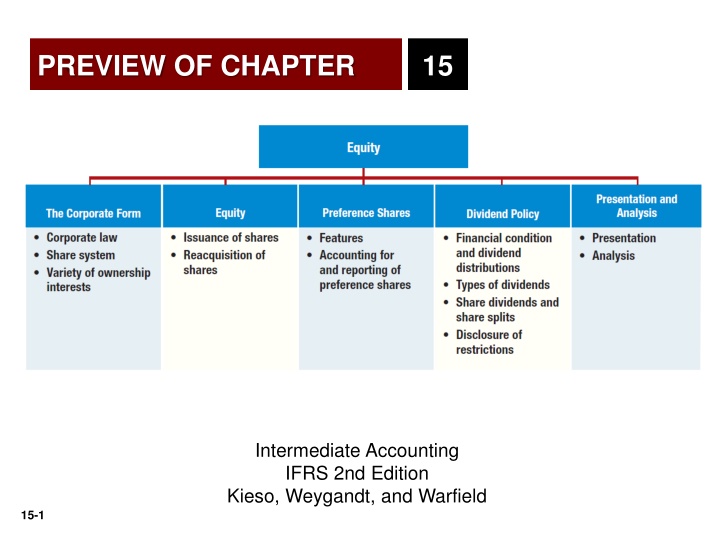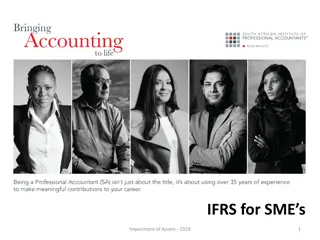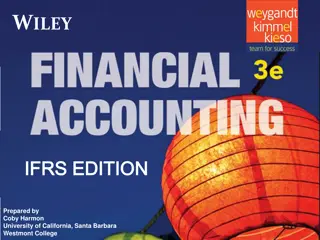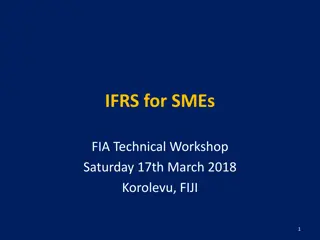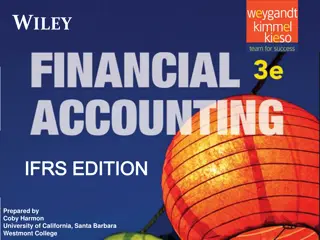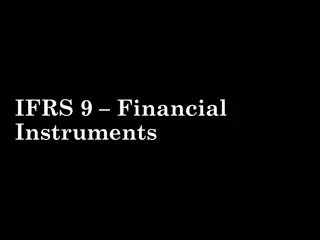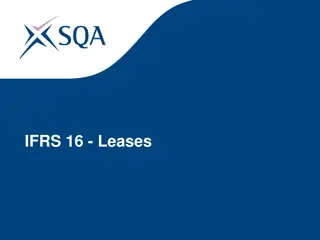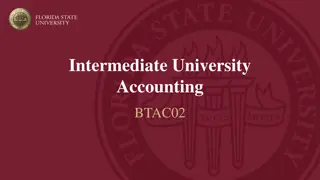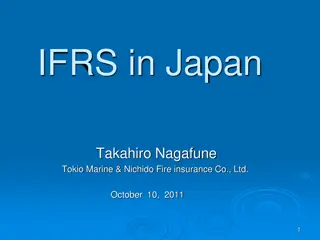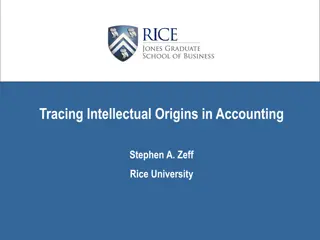Intermediate Accounting IFRS - Equity Reporting and Analysis
This preview of Chapter 15 from the Intermediate Accounting IFRS 2nd Edition explores the accounting and reporting aspects of equity, including preference shares, dividend policies, share issuance procedures, treasury shares, and equity analysis. The chapter covers the characteristics of the corporate form of organization, key components of equity, dividend distributions, share dividends, and more.
Download Presentation

Please find below an Image/Link to download the presentation.
The content on the website is provided AS IS for your information and personal use only. It may not be sold, licensed, or shared on other websites without obtaining consent from the author.If you encounter any issues during the download, it is possible that the publisher has removed the file from their server.
You are allowed to download the files provided on this website for personal or commercial use, subject to the condition that they are used lawfully. All files are the property of their respective owners.
The content on the website is provided AS IS for your information and personal use only. It may not be sold, licensed, or shared on other websites without obtaining consent from the author.
E N D
Presentation Transcript
PREVIEW OF CHAPTER 15 Intermediate Accounting IFRS 2nd Edition Kieso, Weygandt, and Warfield 15-1
15 Equity LEARNING OBJECTIVES After studying this chapter, you should be able to: 5. Explain the accounting for and reporting of preference shares. 1. Discuss the characteristics of the corporate form of organization. 6. Describe the policies used in distributing dividends. 2. Identify the key components of equity. 7. Identify the various forms of dividend distributions. 3. Explain the accounting procedures for issuing shares. 8. Explain the accounting for share dividends and share splits. 4. Describe the accounting for treasury shares. 9. Indicate how to present and analyze equity. 15-2
CORPORATE FORM OF ORGANIZATION Three primary forms of business organization. Proprietorship Partnership Corporation Special characteristics of the corporate form: 1. Influence of state corporate law. 2. Use of the share system. 3. Development of a variety of ownership interests. LO 1 15-3
CORPORATE FORM OF ORGANIZATION Share System In the absence of restrictive provisions, each share carries the following rights: 1. To share proportionately in profits and losses. 2. To share proportionately in management (the right to vote for directors). 3. To share proportionately in assets upon liquidation. 4. To share proportionately in any new issues of shares of the same class called the preemptive right. LO 1 15-4
CORPORATE FORM OF ORGANIZATION Variety of Ownership Interests Ordinary shares represent the residual corporate interest. Bears ultimate risks of loss. Receives the benefits of success. Not guaranteed dividends nor assets upon dissolution. Preference shares are created by contract, when shareholders sacrifice certain rights in return for other rights or privileges, usually dividend preference. LO 1 15-5
15 Equity LEARNING OBJECTIVES After studying this chapter, you should be able to: 1. Discuss the characteristics of the corporate form of organization. 5. Explain the accounting for and reporting of preference shares. 6. Describe the policies used in distributing dividends. 2. Identify the key components of equity. 7. Identify the various forms of dividend distributions. 3. Explain the accounting procedures for issuing shares. 8. Explain the accounting for share dividends and share splits. 4. Describe the accounting for treasury shares. 9. Indicate how to present and analyze equity. 15-6
EQUITY Equity is often subclassified on the statement of financial position into the following categories 1. Share capital. 2. Share premium. 3. Retained earnings. 4. Accumulated other comprehensive income. 5. Treasury shares. 6. Non-controlling interest (minority interest). LO 2 15-7
EQUITY Ordinary Shares Account Contributed Capital Share Premium Account Preference Shares Account Two Primary Sources of Equity Retained Earnings Account Assets Liabilities = Equity Less: Treasury Shares Account LO 2 15-8
15 Equity LEARNING OBJECTIVES After studying this chapter, you should be able to: 1. Discuss the characteristics of the corporate form of organization. 5. Explain the accounting for and reporting of preference shares. 2. Identify the key components of equity. 6. Describe the policies used in distributing dividends. 3. Explain the accounting procedures for issuing shares. 7. Identify the various forms of dividend distributions. 4. Describe the accounting for treasury shares. 8. Explain the accounting for share dividends and share splits. 9. Indicate how to present and analyze equity. 15-9
EQUITY Issuance of Shares Accounting problems involved in the issuance of shares: 1. Par value shares. 2. No-par shares. 3. Shares issued in combination with other securities. 4. Shares issued in non-cash transactions. 5. Costs of issuing shares. LO 3 15-10
EQUITY Par Value Shares Low par values help companies avoid a contingent liability. Corporations maintain accounts for: Preference Shares or Ordinary Shares. Share Premium. LO 3 15-11
EQUITY No-Par Shares Reasons for issuance: Avoids contingent liability. Avoids confusion over recording par value versus fair market value. A major disadvantage of no-par shares is that some countries levy a high tax on these issues. In addition, in some countries the total issue price for no-par shares may be considered legal capital, which could reduce the flexibility in paying dividends. LO 3 15-12
EQUITY Illustration: Video Electronics Corporation is organized with 10,000 ordinary shares authorized without par value. If Video Electronics issues 500 shares for cash at 10 per share, it makes the following entry. Cash 5,000 Share Capital Ordinary 5,000 Video Electronics issues another 500 shares for 11 per share. Cash 5,500 Share Capital Ordinary 5,500 LO 3 15-13
EQUITY Illustration: Some countries require that no-par shares have a stated value. If a company issued 1,000 of the shares with a 5 stated value at 15 per share for cash, it makes the following entry. Cash 15,000 Share Capital Ordinary 5,000 Share Premium Ordinary 10,000 LO 3 15-14
EQUITY Shares Issued with Other Securities Two methods of allocating proceeds: Proportional method. Incremental method. LO 3 15-15
EQUITY BE15-4: Ravonette Corporation issued 300 shares of $10 par value ordinary shares and 100 shares of $50 par value preference shares for a lump sum of $13,500. The ordinary shares have a market value of $20 per share, and the preference shares have a market value of $90 per share. Number 300 100 Amount $ Fair Market Value Total 6,000 $ 9,000 15,000 $ Percent Ordinary shares Preference shares x x 20.00 90.00 = 40% 60% 100% Allocation: Issue price Allocation % Total Ordinary 13,500 $ Preference 13,500 $ Proportional Method 40% 5,400 60% 8,100 $ $ LO 3 15-16
EQUITY BE15-4: Ravonette Corporation issued 300 shares of $10 par value ordinary shares and 100 shares of $50 par value preference shares for a lump sum of $13,500. The ordinary shares have a market value of $20 per share, and the preference shares have a market value of $90 per share. Journal entry (Proportional): Cash 13,500 Share Capital Preference (100 X $50) Share Premium Preference Share Capital Ordinary (300 X $10) Share Premium Ordinary 5,000 3,100 3,000 2,400 LO 3 15-17
EQUITY BE15-4 (Variation): Ravonette Corporation issued 300 shares of $10 par value ordinary shares and 100 shares of $50 par value preference shares for a lump sum of $13,500. The ordinary shares have a market value of $20 per share, and the value of preference shares are unknown. Number 300 100 Amount $ Total 6,000 $ 6,000 $ Ordinary shares Preference shares x x Fair Market Value 20.00 = - Allocation: Issue price Ordinary Total Ordinary Preference 13,500 $ $ Incremental Method (6,000) 7,500 $ 6,000 LO 3 15-18
EQUITY BE15-4 (Variation): Ravonette Corporation issued 300 shares of $10 par value ordinary shares and 100 shares of $50 par value preference shares for a lump sum of $13,500. The ordinary shares have a market value of $20 per share, and the value of preference shares are unknown. Journal entry (Incremental): Cash 13,500 Share Capital Preference (100 X $50) Share Premium Preference Share Capital Ordinary (300 X $10) Share Premium Ordinary 5,000 2,500 3,000 3,000 LO 3 15-19
EQUITY Shares Issued in Noncash Transactions The general rule: Companies should record shares issued for services or property other than cash at the fair value of the goods or services received. If the fair value of the goods or services cannot be measured reliably, use the fair value of the shares issued. LO 3 15-20
EQUITY Illustration: The following series of transactions illustrates the procedure for recording the issuance of 10,000 shares of 10 par value ordinary shares for a patent for Marlowe Company, in various circumstances. 1. Marlowe cannot readily determine the fair value of the patent, but it knows the fair value of the shares is 140,000. Patent 140,000 Share Capital Ordinary 100,000 Share Premium Ordinary 40,000 LO 3 15-21
EQUITY 2. Marlowe cannot readily determine the fair value of the shares, but it determines the fair value of the patent is 150,000. Patent 150,000 Share Capital Ordinary 100,000 Share Premium Ordinary 50,000 LO 3 15-22
EQUITY 3. Marlowe cannot readily determine the fair value of the shares nor the fair value of the patent. An independent consultant values the patent at 125,000 based on discounted expected cash flows. Patent 125,000 Share Capital Ordinary 100,000 Share Premium Ordinary 25,000 LO 3 15-23
EQUITY Costs of Issuing Stock Direct costs incurred to sell shares, such as underwriting costs, accounting and legal fees, printing costs, and taxes, should reduce the proceeds received from the sale of the shares. LO 3 15-24
15 Equity LEARNING OBJECTIVES After studying this chapter, you should be able to: 1. Discuss the characteristics of the corporate form of organization. 5. Explain the accounting for and reporting of preference shares. 2. Identify the key components of equity. 6. Describe the policies used in distributing dividends. 3. Explain the accounting procedures for issuing shares. 7. Identify the various forms of dividend distributions. 4. Describe the accounting for treasury shares. 8. Explain the accounting for share dividends and share splits. 9. Indicate how to present and analyze equity. 15-25
EQUITY Reacquisition of Shares Corporations purchase their outstanding shares to: Provide tax-efficient distributions of excess cash to shareholders. Increase earnings per share and return on equity. Provide shares for employee compensation contracts or to meet potential merger needs. Thwart takeover attempts or to reduce the number of shareholders. Make a market in the shares. LO 4 15-26
EQUITY Purchase of Treasury Shares Two acceptable methods: Cost method (more widely used). Par or Stated value method. Treasury shares reduces equity. LO 4 15-27
EQUITY Illustration: Pacific Company issued 100,000 shares of $1 par value ordinary shares at a price of $10 per share. In addition, it has retained earnings of $300,000. ILLUSTRATION 15-4 Equity with No Treasury Shares LO 4 15-28
EQUITY Illustration: Pacific Company issued 100,000 shares of $1 par value ordinary shares at a price of $10 per share. In addition, it has retained earnings of $300,000. On January 20, 2015, Pacific acquires 10,000 of its shares at $11 per share. Pacific records the reacquisition as follows. Treasury Shares 110,000 Cash 110,000 LO 4 15-29
EQUITY Illustration: The equity section for Pacific after purchase of the treasury shares. ILLUSTRATION 15-5 Equity with Treasury Shares LO 4 15-30
EQUITY Sale of Treasury Shares Above Cost Below Cost Both increase total assets and equity. LO 4 15-31
EQUITY Sale of Treasury Shares above Cost. Pacific acquired 10,000 treasury shares at $11 per share. It now sells 1,000 shares at $15 per share on March 10. Pacific records the entry as follows. Cash 15,000 Treasury Shares 11,000 Share Premium Treasury 4,000 LO 4 15-32
EQUITY Sale of Treasury Shares below Cost. Pacific sells an additional 1,000 treasury shares on March 21 at $8 per share, it records the sale as follows. Cash 8,000 Share Premium Treasury 3,000 Treasury Shares 11,000 LO 4 15-33
EQUITY ILLUSTRATION 15-6 Treasury Share Transactions in Share Premium Treasury Account Illustration: Assume that Pacific sells an additional 1,000 shares at $8 per share on April 10. Cash Share Premium Treasury Retained Earnings Treasury Shares 8,000 1,000 2,000 11,000 LO 4 15-34
EQUITY Retiring Treasury Shares Decision results in cancellation of the treasury shares and a reduction in the number of shares of issued shares. Retired treasury shares have the status of authorized and unissued shares. LO 4 15-35
15 Equity LEARNING OBJECTIVES After studying this chapter, you should be able to: 1. Discuss the characteristics of the corporate form of organization. 6. Describe the policies used in distributing dividends. 2. Identify the key components of equity. 7. Identify the various forms of dividend distributions. 3. Explain the accounting procedures for issuing shares. 8. Explain the accounting for share dividends and share splits. 4. Describe the accounting for treasury shares. 9. Indicate how to present and analyze equity. 5. Explain the accounting for and reporting of preference shares. 15-36
PREFERENCE SHARES Features often associated with preference shares. 1. Preference as to dividends. 2. Preference as to assets in the event of liquidation. 3. Convertible into ordinary shares. 4. Callable at the option of the corporation. 5. Non-voting. LO 5 15-37
PREFERENCE SHARES Features of Preference Shares Cumulative A corporation may attach whatever preferences or restrictions, as long as it does not violate its country s incorporation law. Participating Convertible Callable Redeemable The accounting for preference shares at issuance is similar to that for ordinary shares. LO 5 15-38
PREFERENCE SHARES Illustration: Bishop Co. issues 10,000 shares of 10 par value preference shares for 12 cash per share. Bishop records the issuance as follows: Cash 120,000 Share Capital Preference 100,000 Share Premium Preference 20,000 LO 5 15-39
15 Equity LEARNING OBJECTIVES After studying this chapter, you should be able to: 1. Discuss the characteristics of the corporate form of organization. 6. Describe the policies used in distributing dividends. 2. Identify the key components of equity. 7. Identify the various forms of dividend distributions. 3. Explain the accounting procedures for issuing shares. 8. Explain the accounting for share dividends and share splits. 4. Describe the accounting for treasury shares. 9. Indicate how to present and analyze equity. 5. Explain the accounting for and reporting of preference shares. 15-40
DIVIDEND POLICY Few companies pay dividends in amounts equal to their legally available retained earnings. Why? Maintain agreements with creditors. Meet corporation requirements. To finance growth or expansion. To smooth out dividend payments. To build up a cushion against possible losses. LO 6 15-41
DIVIDEND POLICY Financial Condition and Dividend Distributions Before declaring a dividend, management must consider availability of funds to pay the dividend. Should not pay a dividend unless both the present and future financial position warrant the distribution. LO 6 15-42
15 Equity LEARNING OBJECTIVES After studying this chapter, you should be able to: 1. Discuss the characteristics of the corporate form of organization. 6. Describe the policies used in distributing dividends. 2. Identify the key components of equity. 7. Identify the various forms of dividend distributions. 3. Explain the accounting procedures for issuing shares. 8. Explain the accounting for share dividends and share splits. 4. Describe the accounting for treasury shares. 9. Indicate how to present and analyze equity. 5. Explain the accounting for and reporting of preference shares. 15-43
DIVIDEND POLICY Types of Dividends Cash dividends. 1. Liquidating dividends. 3. Property dividends. 2. Share dividends. 4. All dividends, except for share dividends, reduce the total equity in the corporation. LO 7 15-44
DIVIDEND POLICY Cash Dividends Board of directors vote on the declaration of cash dividends. A declared cash dividend is a liability. Companies do not declare or pay cash dividends on treasury shares. Three dates: a. Date of declaration b. Date of record c. Date of payment LO 7 15-45
DIVIDEND POLICY Illustration: Roadway Freight Corp. on June 10 declared a cash dividend of 50 cents a share on 1.8 million shares payable July 16 to all shareholders of record June 24. At date of declaration (June 10) Retained Earnings Dividends Payable 900,000 900,000 At date of record (June 24) No entry At date of payment (July 16) Dividends Payable Cash 900,000 900,000 LO 7 15-46
DIVIDEND POLICY Property Dividends Dividends payable in assets other than cash. Restate at fair value the property it will distribute, recognizing any gain or loss. LO 7 15-47
DIVIDEND POLICY Illustration: Tsen, Inc. transferred to shareholders some of its investments (held-for-trading) in securities costing HK$1,250,000 by declaring a property dividend on December 28, 2014, to be distributed on January 30, 2015, to shareholders of record on January 15, 2015. At the date of declaration the securities have a fair value of HK$2,000,000. Tsen makes the following entries. At date of declaration (December 28, 2014) Equity Investments Unrealized Holding Gain or Loss Income 750,000 750,000 Retained Earnings Property Dividends Payable 2,000,000 2,000,000 LO 7 15-48
DIVIDEND POLICY Illustration: Tsen, Inc. transferred to shareholders some of its investments (held-for-trading) in securities costing HK$1,250,000 by declaring a property dividend on December 28, 2014, to be distributed on January 30, 2015, to shareholders of record on January 15, 2015. At the date of declaration the securities have a fair value of HK$2,000,000. Tsen makes the following entries. At date of distribution (January 30, 2015) Property Dividends Payable Equity Investments 2,000,000 2,000,000 LO 7 15-49
DIVIDEND POLICY Liquidating Dividends Any dividend not based on earnings reduces amounts paid-in by shareholders. LO 7 15-50
